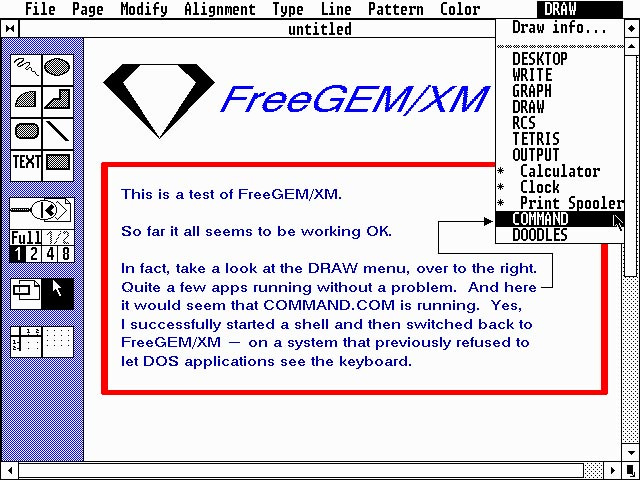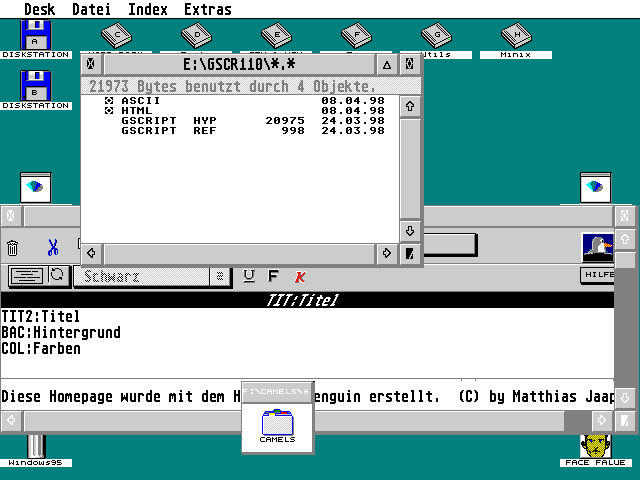FreeGEM/XM -- The open source version of the unreleased, multi-tasking GEM
Because unreleased, 1980s operating systems are cool.
The Lunduke Journal is 100% independent — with no corporate influence — and is supported entirely by subscribers just like you. Also, you get a ton of cool perks in the process. 10 books (and counting), video games… the works.
GEM, the “Graphical Environment Manager” from Gary Kildall’s Digital Research, has a turbulent and fascinating history (which we’ve talked about some of before).
One rather curious tidbit that doesn’t get talked about much:
In 1986, a project called “GEM/XM” was started within Digital Research. The idea was to bring multitasking to the GEM environment. (Which, up until then, had been strictly a “one application at a time” system… much like the Mac System Software of the day.)
Unfortunately, GEM/XM never made it to market. Luckily, we now have the source code for it (under the GPL, thanks to the source being licensed that way and released by Caldera Thin Clients back in 1999).
This is what GEM/XM looked like when development stopped in 1986/1987:
You’ll notice a few things right off the bat:
First and foremost… no drive or trash icons are visible on the desktop. Also… the two windows being displayed are tiled… not overlapping or resizable.
This is due to the fact that Apple Computer sued Digital Research because Apple felt like GEM looked too similar to the Mac System Software.
Digital Research settled, gave Apple a bunch of money (the amount was never disclosed) and removed a number of features from GEM (including overlapping windows, and icons on the desktop).
For reference, this is what GEM looked like before Apple sued Digital Research:
Over the years since the source code for GEM (including GEM/XM) was released, a small community of programmers have been slowly adding those features back into the now open source GEM desktop.
For example, here is one of the more recent versions of FreeGEM (the non-XM variety) running. Icons on the desktop. Movable windows. The whole nine yards.
And work on the GEM/XM codebase has continued as well — in the form of FreeGEM/XM. You can grab FreeGEM/XM 3.0 Beta 4 from the deltasoft.com download page.
It looks like this:
Note the multiple applications running are listed in that top right drop down menu.
From the news page on deltasoft.com:
GEM/XM, the taskswitching high-memory aware version of GEM that DRI appeared to have abandoned in the mid 1980s, has been released under the GPL as FreeGEM/XM 3.0 beta 4. The FreeGEM/XM version fixes a slight problem with the original which rendered machines inoperable when a DOS application was started. Currently, the only available FreeGEM/XM is a quick distribution, available from the Downloads page, although a new version complete with the enhanced FreeGEM 3.15 Desktop should be available soon.
Progress on FreeGEM (and FreeGEM/XM) is not exactly happening at a lightning fast pace — often many years between updates. But the fact that developers are keeping this codebase moving forward at all is nothing short of wonderful.
I would love to see FreeGEM/XM (which has multitasking) combined together with the most recent updates to the desktop of the core FreeGEM… and then combined with some of the drivers which allow VESA, 256 color graphics.
With all of that we could end up with a “DOS PC” version of GEM that is comparable to the Atari ST version of “Multi-TOS” (which was a fork of GEM).
A few thoughts based on what we’ve just talked about:
FreeGEM (and FreeGEM/XM) is a fascinating, GPL’d base for a lightweight graphical desktop. I can see some practical uses if a little investment can be done in the codebase.
I would absolutely love to see development continue on FreeGEM. If, for no other reason, than to see what GEM might have been like had things gone differently in the industry.
We have the full source for GEM. We have some source used in early Windows and DOS versions. Yet Apple… who does not profit in any way shape or form from early Mac System Software… keeps everything locked down. From a computer history perspective, this is a shame.
At any rate, you can grab various FreeGEM (and FreeGEM/XM) builds from Deltasoft.com. I highly recommend running them in a full PC emulator running era appropriate DR-DOS for the best results.
Have you considered becoming a Founding Member subscriber of The Lunduke Journal?
It comes with some pretty sweet perks (including video chats and other fun goodies).
Highly recommended.


![[GEM/XM desktop] [GEM/XM desktop]](https://substackcdn.com/image/fetch/$s_!NFvq!,w_1456,c_limit,f_auto,q_auto:good,fl_progressive:steep/https%3A%2F%2Fbucketeer-e05bbc84-baa3-437e-9518-adb32be77984.s3.amazonaws.com%2Fpublic%2Fimages%2F07dba812-0231-499e-b3f7-c8b07423d4d9_642x482.png)

![[FreeGEM desktop] [FreeGEM desktop]](https://substackcdn.com/image/fetch/$s_!tsdC!,w_1456,c_limit,f_auto,q_auto:good,fl_progressive:steep/https%3A%2F%2Fbucketeer-e05bbc84-baa3-437e-9518-adb32be77984.s3.amazonaws.com%2Fpublic%2Fimages%2F590b1d25-d360-4d7b-a360-34380928a2e3_642x482.png)


GEM is great, but I'll have to admit, my first love of this era was DesqView/QEMM. Perhaps extending DOS *is* viable after all with this open source project :)